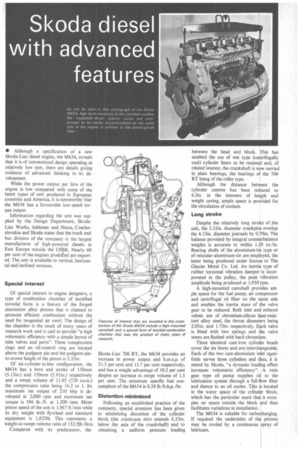Skoda diesel with advanced features
Page 45

If you've noticed an error in this article please click here to report it so we can fix it.
• Although a specification of a new Skoda-Liaz diesel engine, the M634, reveals that it is of conventional design operating at relatively low rpm, there are details giving evidence of advanced thinking in its development.
While the power output per litre of the engine is low compared with some of the latest types of unit produced in European countries and America, it is noteworthy that the M634 has a favourable low-speed torque output.
Information regarding the unit was supplied by the Design Department, SkodaLiaz Works, Jablonec and Nisou, Czechoslovakia and Skoda states that the truck and bus division of the company is the largest manufacturer of high-powered diesels in East Europe outside the USSR. Nearly 60 per cent of the engines produted are exported. The unit is available in vertical, horizontal and inclined versions.
Special interest Of special interest to engine designers, a type of combustion chamber of modified toroidal form is a feature of the forged aluminium alloy pistons that is claimed to promote efficient combustion without the need for tangential air swirl. The design of the chamber is the result of many years of research work and is said to provide "a high volumetric efficiency with a simple layout of inlet valves and ports". Three compression rings and an oil-control ring are located above the gudgeon pin and the gudgeon-pinto-crown height of the piston is 3.35in.
Of six-cylinder-in-line configuration, the M634 has a bore and stroke of 130mm (5.12in.) and 150mm (5.91in.) respectively and a swept volume of 11.95 (729 cu.in.) the compression ratio being 16.2 to 1. Its maximum net output of 210 bhp is developed at 2,000 rpm and maximum net torque is 586 lb./ft. at 1,300 rpm. Mean piston speed of the unit is 1.967 ft /min while its dry weight with flywheel and standard equipment is 1.8221b. This represents a weight-to-swept-volume ratio of 152.5b /litre.
Compared with its predecessor, the Skoda-Liaz 706 RT, the M634 provides an increase in power output and b.m.e.p. of 31.3 per cent and 15.7 per cent respectively, and has a weight advantage of 10.3 per cent despite an increase in .swept volume of 1.5 per cent. The minimum specific fuel consumption of the M634 is 0.38 lb /b.h.p. /hr.
Distortion minimized Following an established practice of the company, special attention has been given to minimizing distortion of the cylinder block (the crankcase skirt extends 4.33in. below the axis of the crankshaft) and to obtaining a uniform pressure loading between the head and block. This has enabled the use of wet type (centrifugally cast) cylinder liners to be retained and, of related interest, the crankshaft is now carried in plain bearings, the bearings of the 706 RT being of the roller type.
Although the distance between the cylinder centres has been reduced to 6.3in. in the interests of length and weight saving, ample space is provided for the circulation of coolant.
Long stroke Despite the relatively long stroke of the unit. the 3.35in. diameter crankpins overlap the 4.13in. diameter journals by 0.79in. The balance provided by integral counterbalance weights is accurate to within 1.39 oz /in. Bearing shells of the aluminium-tin type or of reticular-aluminium-tin are employed, the latter being produced under licence to The Glacier Metal Co. Ltd. An inertia type of rubber torsional vibration damper is incorporated in the pulley, the peak vibration amplitude being produced at 1,950 rpm.
A high-mounted camshaft provides ample space for the fuel pump, air compressor and centrifugal oil filter on the same side and enables the inertia mass of the valve gear to be reduced. Both inlet and exhaust valves are of chromium-silicon heat-resistant alloy steel, the throat diameters being 2.05in. and 1.73in. respectively. Each valve is fitted with two springs and the valve stems are flashed with hard chromium.
Three identical cast-iron cylinder heads cover the six bores and are interchangeable. Each of the two cast-aluminium inlet manifolds serves three cylinders and thus, it is stated by Skoda, "a dynamic loading effect increases volumetric efficiency". A twin gear type oil pump supplies oil to the lubrication system through a full-flow filter and thence to an oil cooler. This is located in the water space of the cylinder block, which has the particular merit that it occupies no space outside the block and thus facilitates variations in installation.
The M634 is suitable for turbocharging. If required the undersides of the pistons may be cooled by a continuous spray of lubricant.






































































































